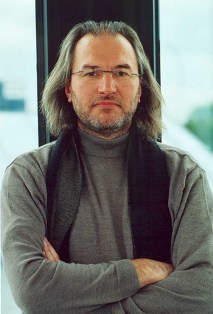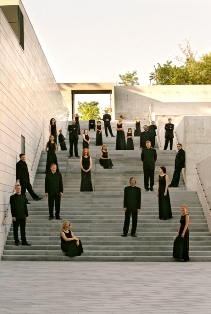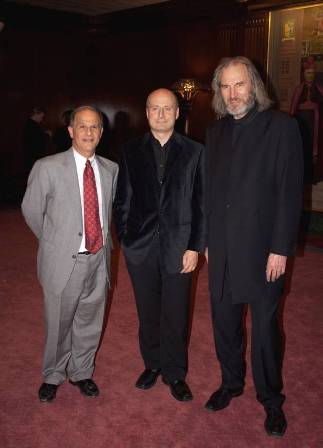
Estonian Choir, Chamber Orchestra Resplendent in Cincinnati Debut

“Tiny but mighty” is an apt descriptor of Estonia, prime real
estate on the Baltic Sea next door to Russia.

The same observation might fit the Estonian Philharmonic Chamber
Choir and Tallinn Chamber Orchestra in their Cincinnati debut Nov. 11 at St. Peter in Chains Cathedral.
The compact 26-voice choir and companion 19-piece string orchestra, led by founding artistic director/conductor Tõnu Kaljuste, filled the imposing gilt-mosaic Cathedral with out-sized beauty to match in music of Arvo Part, Erkki-Sven Tüür and Vivaldi.
Currently on an 11-city tour of the U.S and Canada, the two ensembles manifest a quality and refinement of sound rarely encountered in the music world today. Partly, it is the culture of the Baltic countries, where music, especially singing is part of a normal education. The rest may be ascribed to the vision and hard work of Kaljuste, a leader in cultivating the fully professional choir (a rather recent development in the history of choral singing). A dynamic conductor who communicates with great fluidity of expression, Kaljuste has had his countrymen and women to help him get the job done, including Pärt, Tüür and Veljo Tormis, a remarkable achievement for a nation of only 1.4 million people.
It was the Cincinnati debut of the two ensembles who, serendipitously, found Cincinnati Symphony Orchestra music director Paavo Järvi in town. Estonian-born Järvi, who sang in choirs in Estonia as a child, introduced them to the audience.
The first half of the program comprised music by Pärt, all belonging to the so-called “tintinnabuli” (bell-like) style which has made him one of the most popular composers in the world today. (Pärt’s often-heard “Cantus in memory of Benjamin Britten” is a quintessential example.) Three of the four selections were written after 2000.
The first, “Orient and Occident” (2000) for string orchestra, demonstrated a synthesis of East and West. In it, a single line with oriental inflections (like sliding into notes) contrasted with sections of dense, western-style harmony.
“Wahlfartslied” (“Pilgrim’s Song”), originally composed in 1984 for solo voice and instruments, was heard in its 2001 adaptation for men’s choir and orchestra. It is a heart-clutching work, based on Psalm 121 (“I will lift up mine eyes unto the hills from whence cometh my help”). Pärt wrote it in response to the death of a friend, Estonian film director Grigori Kromanov. The men’s voices were separated, half singing in the nave of the Cathedral, the others from the transept, always serenely in unison against the TCO, which created textures and sometimes harsh effects reflective of the tragedy and turbulence of life.
“L’Abbe Agathon” (2004-05) -- originally for soprano and
eight cellos, heard here as adapted for women’s choir and orchestra -- is a kind of sacred scene depicting an
encounter between a French monk (Brother Agathon) and a leper., who is, in
fact, an angel in disguise. Again, the
choir was divided spatially. A solo
soprano and tenor sang occasional lines as the leper and Agathon. It is
a gorgeous – actually quite romantic -- work that reached a dramatic climax as
the angel’s identity is revealed in exchanges between the choir and tremolo strings
(rapid bowing on a single pitch). Followed
this to conclude the first half was “Da pacem,” a sublime a capella piece for
mixed choir, that represented Pärt
in his purest “mystic minimalist“ mode. A prayer for “peace in our time, O Lord“ (“because
there is none other that fighteth for us“), it made a moving statement for just that. The men’s and women’s voices answered each
other to slowly shifting harmonies, ending with an open fifth that became a D-minor triad
with the addition of the missing third by the men.
Tüür’s “Action, Passion, Illusion” opened the second half of the program. As CSO concertgoers know, Tüür’s music is vibrant, colorful and often challenging, having appeared several times on CSO programs. Premiered by Kaljuste and the TCO in 1993, this triptych for strings is an excellent showcase for his imagination and skills. Kaljuste, who has been expanding his repertoire and his career through purely orchestral conducting, led a glowing performance of these well-named pieces. “Action” leapt like droplets in a frying pan before sizzling out at the end. “Passion” began low in the cellos and basses, expanding through the orchestral texture like ink in water. Expressively, it suggested a kind of Henryk Gorecki (Symphony No. 3) meets Samuel Barber (Adagio for Strings), finally breaking through the surface into myriad points of color. The influence of Tüür’s teacher, the late Estonian composer Lepo Sumera, could be detected, too, in its feeling of exaltation. “Illusion,” called by Tüür the “deconstruction of a baroque motif,” was full of jazzy, kicky motion, ending in a fadeout.
A kind of post-election feature was Antonio Vivaldi’s “Beatus vir,” KV 597, a setting of Psalm 112, “Blessed is the man who fears the Lord . . .” Composed in the grand Venetian tradition with two choirs and two orchestras performing antiphonally, it was intended, said Kaljuste, as a kind of comment on the American presidential election. “One orchestra Republican, the other Democrats . . . seen with these eyes, it’s fun.” It was not only fun but musically splendorous. Though the Cathedral’s reverberant acoustics tended to blur contrapuntal lines, the effect was quite rewarding, the two groups aligned on the left and right of the nave, with portative organ in the middle.
“Beatus vir” opened in light-footed baroque style, announcing the antiphon that would be repeated between movements. “Potens in terra erit semen ejus” (“His children will be mighty in the land”) was announced by the men, while the sopranos’ coloratura pictured the abundance of his “fame and riches.” The TCO provided an atmospheric introduction to “Exortum est in tenebris lumen rectis” (“Even in darkness, light dawns”). Similarly, the trio “In memoria aeterna erit Justus” (“A righteous man will be remembered forever”) for alto, tenor and bass with muted strings, recalled the lovely second movement of Vivaldi's well known “Gloria.”
Shading of dynamics was superb in the chorus “Paratum cor ejus sperare in Domino” (“His heart is steadfast trusting in the Lord”) and for pure virtuosity, Cincinnati has rarely seen a tenor with such coloratura facility as Raul Mikson in “Peccator videbit, et irascetur” (“The wicked man will see and be vexed”).
The final chorus “Gloria Patri et Filio, et Spiritu Sancto” (“Glory to the Father, and to the Son and to the Holy Spirit”) made a joyful noise, if indeed, “noise” could ever be the right word for this amazing choir.
Called back for an encore, Kaljuste led the company in a
lullaby-like Christmas song by Estonian Tõnu Korvits, turning to signal the audience to hum along at the end.
